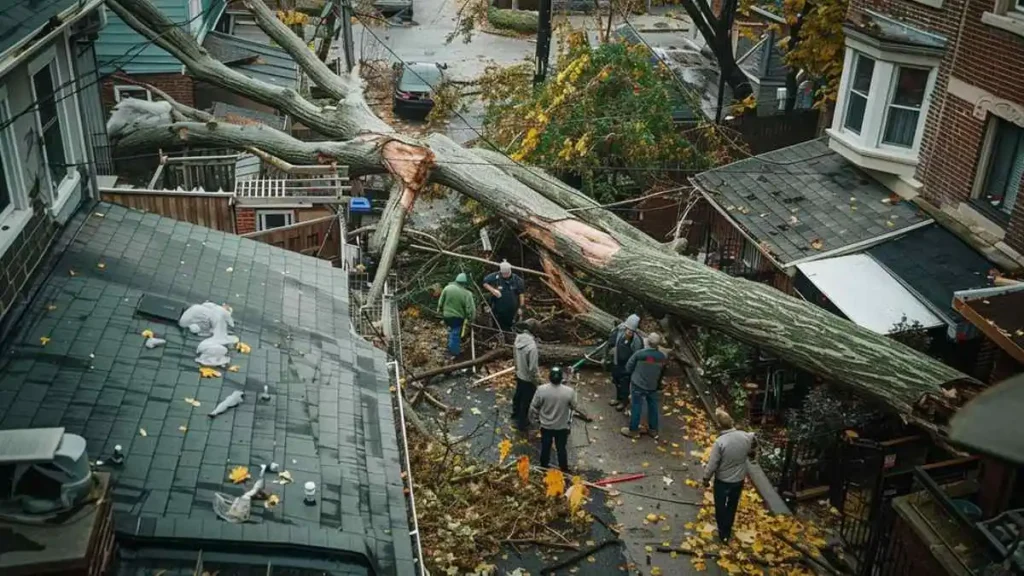GENERAL
Preparing for the Worst: Essential Steps for Effective Storm Damage Mitigation

Storms can wreak havoc on homes and properties, leaving behind a trail of destruction that ranges from minor cosmetic damage to significant structural harm. While the severity of a storm cannot be controlled, the extent of the damage it causes can be mitigated with proper preparation. Effective storm damage mitigation involves a combination of preventative measures, timely action, and strategic planning to protect your property and reduce the potential impact of severe weather.
In this article, we’ll explore the essential steps you can take to prepare for and mitigate storm damage, ensuring that your home and family are as safe as possible when the next big storm hits.
Table of Contents
Assessing Vulnerabilities: Identifying Potential Weak Points
The first step in storm damage mitigation is understanding where your home is most vulnerable. Every property has unique characteristics that can influence how it stands up to a storm, so conducting a thorough assessment is crucial.
1.1 Inspecting the Roof and Gutters
- Roof Condition: The roof is your home’s first line of defense against storms. Inspect it for loose or missing shingles, damaged flashing, and other signs of wear that could allow water to seep in during heavy rains. Consider reinforcing the roof with hurricane straps or clips to better secure it against high winds.
- Gutters and Downspouts: Clear gutters and downspouts of any debris to ensure they can effectively channel water away from your home. Clogged gutters can lead to water overflow, causing damage to your roof, siding, and foundation.
1.2 Evaluating Windows and Doors
- Window Protection: Windows are particularly vulnerable during storms, especially those that bring high winds or flying debris. Consider installing storm shutters or impact-resistant windows to protect against breakage. At a minimum, have plywood or metal panels ready to cover windows in case of an impending storm.
- Door Reinforcement: Ensure that all exterior doors are strong and secure. Reinforce doors with heavy-duty deadbolts, and consider adding a secondary locking mechanism or a storm door for added protection.
1.3 Yard and Landscaping
- Tree Maintenance: Overhanging branches and dead trees can become dangerous projectiles during a storm. Regularly trim trees and remove any that are dead or unstable to reduce the risk of them falling onto your home.
- Secure Loose Items: Patio furniture, grills, and other outdoor items should be secured or brought indoors before a storm. Loose objects can become airborne in high winds, causing damage to your home or neighboring properties.
Creating a Storm-Ready Home: Reinforcement and Protection
Once you’ve identified the weak points in your property, the next step is to reinforce and protect these areas. Investing in storm-resistant upgrades and ensuring that your home is equipped to handle severe weather can make a significant difference in the outcome.
2.1 Storm-Resistant Building Materials
- Upgrading to Impact-Resistant Materials: Consider upgrading to impact-resistant windows, doors, and roofing materials that are designed to withstand extreme weather conditions. These materials may come at a higher initial cost, but they offer long-term protection and can reduce the need for repairs after a storm.
- Flood Barriers: If your home is in a flood-prone area, consider installing flood barriers or flood-proofing your basement. Elevating critical systems, such as HVAC units and electrical panels, can also help prevent water damage.
2.2 Reinforcing the Structure
- Wall Anchors and Bracing: In areas prone to tornadoes or hurricanes, reinforce walls with anchors or bracing to improve structural stability. This can prevent walls from buckling under pressure or collapsing during extreme weather.
- Roof-to-Wall Connections: Strengthen the connections between your roof and walls using hurricane straps or clips. These devices help secure the roof to the walls, reducing the risk of it being torn off during high winds.
2.3 Backup Power and Utilities
- Generator Installation: Power outages are common during storms, so having a backup generator can keep essential systems running. Choose a generator that is appropriately sized for your home’s needs and ensure it is properly installed and maintained.
- Surge Protection: Install surge protectors on your home’s electrical system to prevent damage to appliances and electronics from power surges caused by lightning or downed power lines.
Developing an Emergency Plan: Preparedness and Response
Even the best-prepared homes can still suffer damage during a severe storm. Having a well-thought-out emergency plan ensures that you and your family know what to do before, during, and after the storm to stay safe and begin the recovery process.

3.1 Family Communication Plan
- Establishing Contact Methods: Develop a communication plan that outlines how your family will stay in touch during a storm. Ensure everyone has a list of emergency contacts and knows how to reach each other if separated. Consider using text messaging, which is more reliable than phone calls during heavy network usage.
- Designated Meeting Places: Identify safe locations inside and outside your home where your family can gather during a storm. For tornadoes, this might be a basement or interior room without windows. For floods, choose higher ground.
3.2 Emergency Supplies Kit
- Essential Supplies: Assemble an emergency kit with supplies to last at least 72 hours. Include non-perishable food, water, medications, flashlights, batteries, and a first-aid kit. Don’t forget supplies for pets if applicable.
- Important Documents: Keep copies of important documents, such as insurance policies, identification, and medical records, in a waterproof container. Having these readily accessible can expedite the recovery process after the storm.
3.3 Evacuation Planning
- Know the Routes: Familiarize yourself with local evacuation routes and shelters. Plan several routes to avoid congested areas and ensure you have a full tank of gas if an evacuation seems likely.
- Pre-Storm Preparations: Before evacuating, turn off utilities like gas, electricity, and water to prevent further damage to your home. Secure your property by locking doors and windows and placing sandbags or flood barriers where needed.
Post-Storm Recovery: Immediate Actions and Long-Term Considerations
After the storm has passed, the focus shifts to recovery. The actions you take immediately after a storm can significantly impact the extent of the damage and the speed of your recovery.
4.1 Safety First: Assessing Damage
- Initial Inspection: Once it is safe to do so, carefully inspect your home for damage. Look for signs of structural damage, such as cracks in the foundation, sagging rooflines, or displaced walls. Avoid entering areas that appear unsafe or unstable.
- Documenting the Damage: Take photos and videos of any damage to your property for insurance purposes. Detailed documentation will help support your claim and ensure you receive the compensation you need for repairs.
4.2 Contacting Professionals
- Restoration Services: For significant damage, contact professional storm damage restoration services that specialize in storm recovery. They have the expertise and equipment to handle water extraction, debris removal, and structural repairs.
- Insurance Claims: Reach out to your insurance company as soon as possible to report the damage and begin the claims process. Provide them with the documentation you’ve gathered and follow their instructions to expedite the process.
4.3 Long-Term Mitigation Strategies
- Rebuilding with Resilience: When repairing or rebuilding, consider incorporating additional storm-resistant features into your home. Strengthening weak points and upgrading materials can reduce the risk of future damage.
- Ongoing Maintenance: Regularly maintain your property to keep it storm-ready. This includes routine inspections, timely repairs, and keeping emergency supplies stocked and accessible.
Conclusion: Proactive Protection Against Storm Damage
Storms are an inevitable part of nature, but their impact doesn’t have to be catastrophic. By taking proactive steps to assess vulnerabilities, reinforce your home, and develop an emergency plan, you can significantly reduce the risk of storm damage. Effective storm damage mitigation is about preparation, resilience, and timely response—ensuring that when the storm passes, you and your property are ready to recover and rebuild.
-

 GENERAL2 months ago
GENERAL2 months agoUncovering the World of кинокрадко: The Dark Side of Film Piracy
-

 GENERAL4 weeks ago
GENERAL4 weeks agoUnveiling the Art of преводсч: How Translators Bridge Language Barriers
-

 YOGA1 year ago
YOGA1 year ago4 Person Yoga Poses for Beginners
-

 GENERAL2 months ago
GENERAL2 months agoThe Journey of iamnobody89757: From Anonymous User to Internet Sensation


























